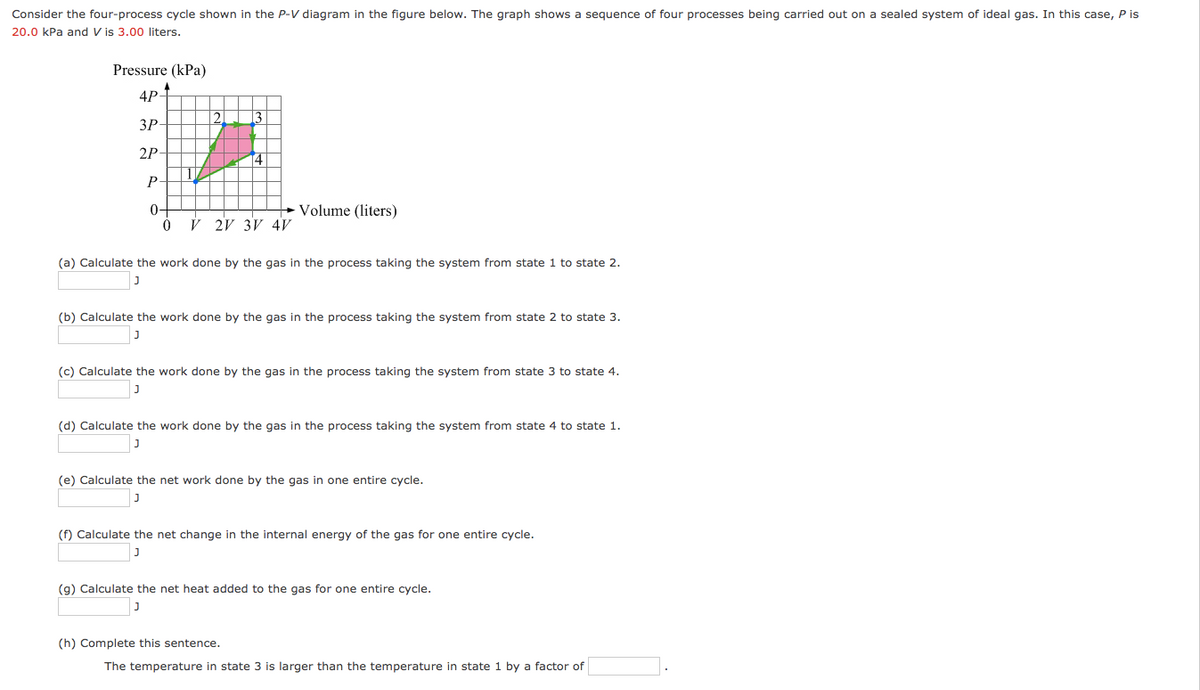Consider the four-process cycle shown in the P-V diagram in the figure below. The graph shows a sequence of four processes being carried out on a sealed system of ideal gas. In this case, Pis 20.0 kPa and V is 3.00 liters. Pressure (kPa) 4Pt 12 13 ЗР- 2P- P- 0- Volume (liters) V 2v 3V 4V (a) Calculate the work done by the gas in the process taking the system from state 1 to state 2. (b) Calculate the work done by the gas in the process taking the system from state 2 to state 3. (c) Calculate the work done by the gas in the process taking the system from state 3 to state 4.
Consider the four-process cycle shown in the P-V diagram in the figure below. The graph shows a sequence of four processes being carried out on a sealed system of ideal gas. In this case, Pis 20.0 kPa and V is 3.00 liters. Pressure (kPa) 4Pt 12 13 ЗР- 2P- P- 0- Volume (liters) V 2v 3V 4V (a) Calculate the work done by the gas in the process taking the system from state 1 to state 2. (b) Calculate the work done by the gas in the process taking the system from state 2 to state 3. (c) Calculate the work done by the gas in the process taking the system from state 3 to state 4.
Principles of Physics: A Calculus-Based Text
5th Edition
ISBN:9781133104261
Author:Raymond A. Serway, John W. Jewett
Publisher:Raymond A. Serway, John W. Jewett
Chapter18: Heat Engines, Entropy, And The Second Law Of Thermodynamics
Section: Chapter Questions
Problem 58P
Related questions
Question
Please answer A-J

Transcribed Image Text:(g) Calculate the net heat added to the gas for one entire cycle.
(h) Complete this sentence.
The temperature in state 3 is larger than the temperature in state 1 by a factor of
(i) Calculate the change in internal energy experienced by the gas during the process that takes the system from state 1 to state 2. Assume that the ideal gas in this system is monatomic.
(j) Calculate the heat added to the gas for the process that takes the system from state 1 to state 2. Assume that the ideal gas in this system is monatomic.

Transcribed Image Text:Consider the four-process cycle shown in the P-V diagram in the figure below. The graph shows a sequence of four processes being carried out on a sealed system of ideal gas. In this case, P is
20.0 kPa and V is 3.00 liters.
Pressure (kPa)
4P-
21
ЗР-
2P-
14
P-
04
→ Volume (liters)
ý 2V 3V 4V
(a) Calculate the work done by the gas in the process taking the system from state 1 to state 2.
(b) Calculate the work done by the gas in the process taking the system from state 2 to state 3.
(c) Calculate the work done by the gas in the process taking the system from state 3 to state 4.
(d) Calculate the work done by the gas in the process taking the system from state 4 to state 1.
(e) Calculate the net work done by the gas in one entire cycle.
(f) Calculate the net change in the internal energy of the gas for one entire cycle.
(g) Calculate the net heat added to the gas for one entire cycle.
(h) Complete this sentence.
The temperature in state 3 is larger than the temperature in state 1 by a factor of
Expert Solution
This question has been solved!
Explore an expertly crafted, step-by-step solution for a thorough understanding of key concepts.
Step by step
Solved in 4 steps

Knowledge Booster
Learn more about
Need a deep-dive on the concept behind this application? Look no further. Learn more about this topic, physics and related others by exploring similar questions and additional content below.Recommended textbooks for you

Principles of Physics: A Calculus-Based Text
Physics
ISBN:
9781133104261
Author:
Raymond A. Serway, John W. Jewett
Publisher:
Cengage Learning


Physics for Scientists and Engineers, Technology …
Physics
ISBN:
9781305116399
Author:
Raymond A. Serway, John W. Jewett
Publisher:
Cengage Learning

Principles of Physics: A Calculus-Based Text
Physics
ISBN:
9781133104261
Author:
Raymond A. Serway, John W. Jewett
Publisher:
Cengage Learning


Physics for Scientists and Engineers, Technology …
Physics
ISBN:
9781305116399
Author:
Raymond A. Serway, John W. Jewett
Publisher:
Cengage Learning

Physics for Scientists and Engineers
Physics
ISBN:
9781337553278
Author:
Raymond A. Serway, John W. Jewett
Publisher:
Cengage Learning

Physics for Scientists and Engineers with Modern …
Physics
ISBN:
9781337553292
Author:
Raymond A. Serway, John W. Jewett
Publisher:
Cengage Learning

Physics for Scientists and Engineers: Foundations…
Physics
ISBN:
9781133939146
Author:
Katz, Debora M.
Publisher:
Cengage Learning